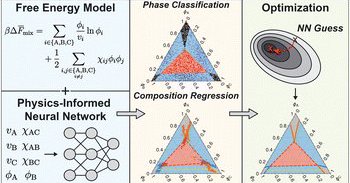
Michael Webb
@xmwebb
Followers
910
Following
412
Media
67
Statuses
613
Asst. Prof., CBE, Princeton; https://t.co/aUCcdMXeSV; https://t.co/WddUU2CBRF; sports/fitness enthusiast. Views my own.
Princeton, NJ
Joined January 2011
(3/3) interestingly, we also identify a rough CG resolution power-law scaling, in which the capacity for models to accurapte capture compressibility degrades beyond a certain resolution, (roughly) irrespective of chemistry. More to be learned there but some practical insights
0
0
1
(2/3) Most CG models are developed using data from the NVT ensemble, producing unphysical pressures and unsuitable for NPT simulations. We propose two simple adaptations to iterative Boltzmann inversion that resolve this issue and provide good compressibilities
1
0
0
(1/3) Sharing our new paper in @JCIM_JCTC from CSI Postdoc Zheng Yu introducing new iterative coarse-graining approaches that yield density/pressure consistency while preserving structural distribution functions: https://t.co/k5eiwCqfI7
1
0
1
(2/2) We evaluate the efficacy of simple metrics to take ML beyond binary classification of phase separation or not. A newly introduced metric--expenditure density--is high-performing and data-efficient. Analyzing failure modes of these metrics is also informative.
0
0
0
(1/2) Excited to share our latest paper in @JPhysChem (led by graduate student Wes Oliver in his first first-author publication!) on predicting the "propensity" for phase separation in coarse-grained IDP models. 🔗 https://t.co/GueM8LSNzN
2
0
10
(3/3) We find that NQEs may have broader relevance than previously appreciated by taking a data-driven approach to their analysis. It's important to be mindful that classical MD frequently neglects NQEs or has such effects "baked in" through the force-field parameterization
0
0
1
(2/3) NQEs arise based on the quantum nature of nuclei (not electrons). The effects are mostly considered at low temperatures or for light nuclei, like hydrogen. Equilibrium isotope effects are an importance consequence of NQEs that would not emerge in purely classical treatments
1
0
0
(1/3) Happy to share new work ( https://t.co/7VxhxZT6e1) by student Eser Ugur in @NatureComms. We characterize room-temperature nuclear quantum effects (NQEs) across 93 organic liquids, understanding the importance of such effects and how their manifestation depends on chemistry
1
0
3
(3/3) What we effectively show here is how coupling a simple (and essentially free) theoretical estimate with an ML algorithm dramatically improves extrapolation capabilities, allowing for data for small MW to be leveraged for larger MW or homopolymers to copolymers, etc.
0
0
0
(2/3) This generally extends our efforts to grow the complexity of polymeric materials amenable to ML but with consideration that our data-generation capabilities can't scale with envisioned complexity.
1
0
0
(1/3) Pleased to share this work from postdoc Bruce Jiang appearing today in @MacroJrnls_ACS on the synergistic application of polymer physics scaling theory and machine learning to predict properties of compositionally and architecturally complex polymers https://t.co/oWzsLVfq8F
1
1
5
Inspired by recent events and being in problem-writing mode for finals, I have crafted the following problem for students at the advanced 1st or 2nd-grade level. The question targets proficiency with the subtraction operator but blends this with real-world concepts:
0
0
0
happy to share our preprint using CG modeling to study structure and dissolution in a (minimal model of a) stress granule -- this was led by the terrific (former senior thesis student) Jay Kaplan (a mere 1.5ish years after his departure from Princeton😅) https://t.co/yjMprn5LDh
0
0
14
I am very sorry to miss #APSSummit25 ! Still a couple of chances to see some work from the group and collaborators.
0
0
5
I know that I am supposed to respond to somebody about something... but I don't know for whom or about what. So, yeah...
3
0
9
Been a minute, but happy to share this work being out in @RSC_MolEng : https://t.co/I9qi0lBkjT We use ML with architectures and losses informed by physical constraints to guide (flash-style) phase-coexistence calculations. Congrats to Sat and @ShengliJiang !
pubs.rsc.org
Phase separation in multicomponent mixtures is of significant interest in both fundamental research and technology. Although the thermodynamic principles governing phase equilibria are straightforw...
0
3
44
I marvel at the fact that we, as a society, have come so far when things like this are deemed acceptable
2
0
4
(3/3) perhaps most strikingly: the rotator phases are exhibit distinct behavior relative to n-alkanes owing to the enchained-ring architecture of the former, allowing for semi-independent segmental rotation, thus influencing the onset and progression of rotational disorder
0
0
0
(2/3) Rotator phases are crystalline states that additionally possess some degree of rotational "disorder." Using MD simulations with a novel force field, we confirm such phases in oligocyclobutanes and elucidate their structural and dynamical characteristics
1
0
0
